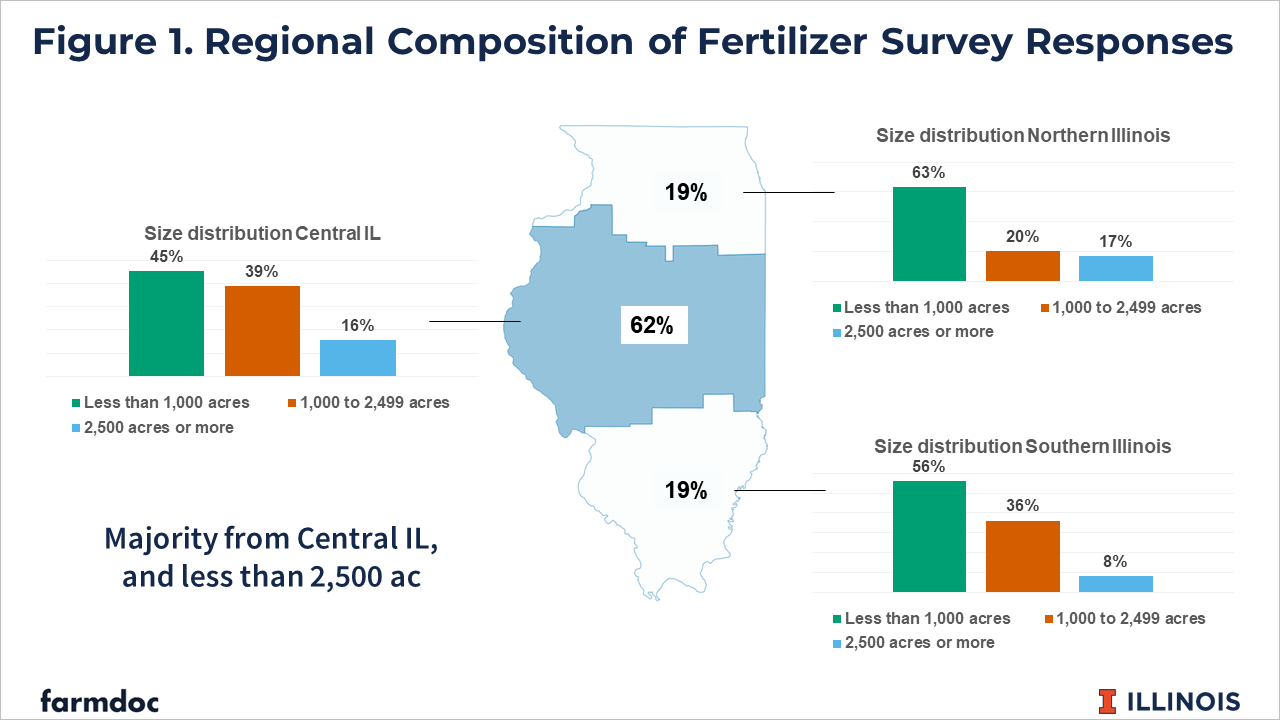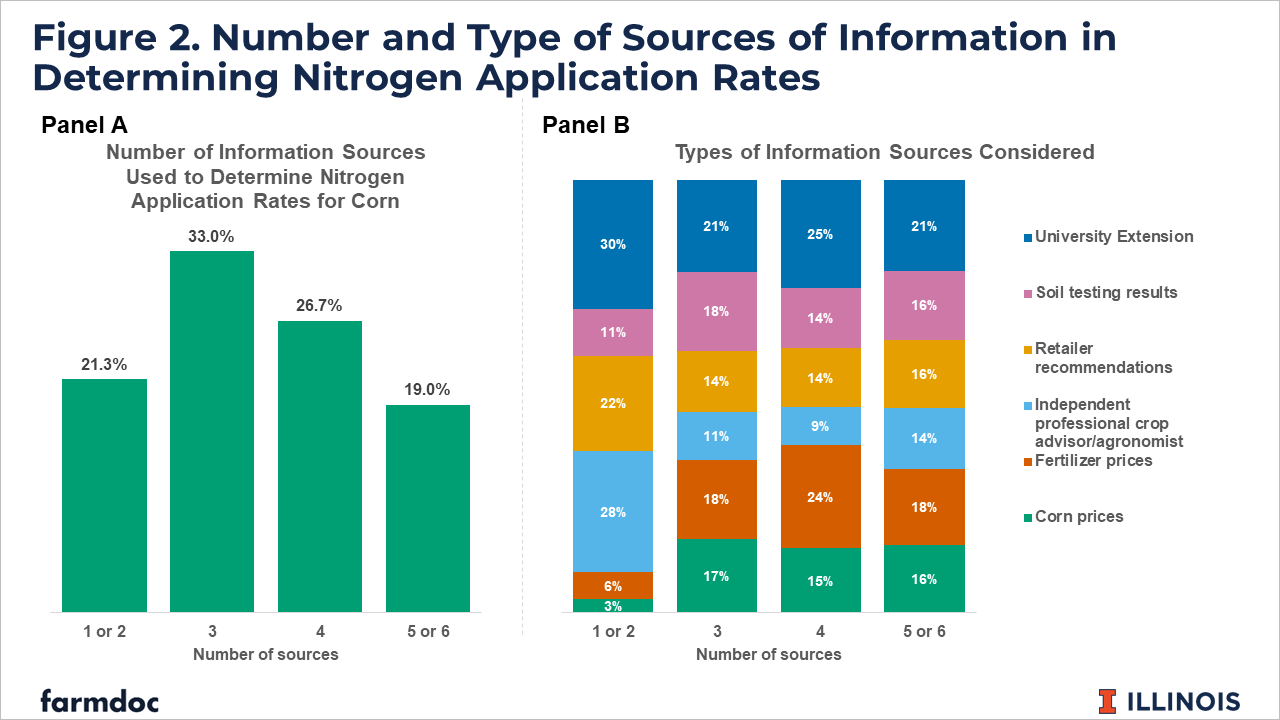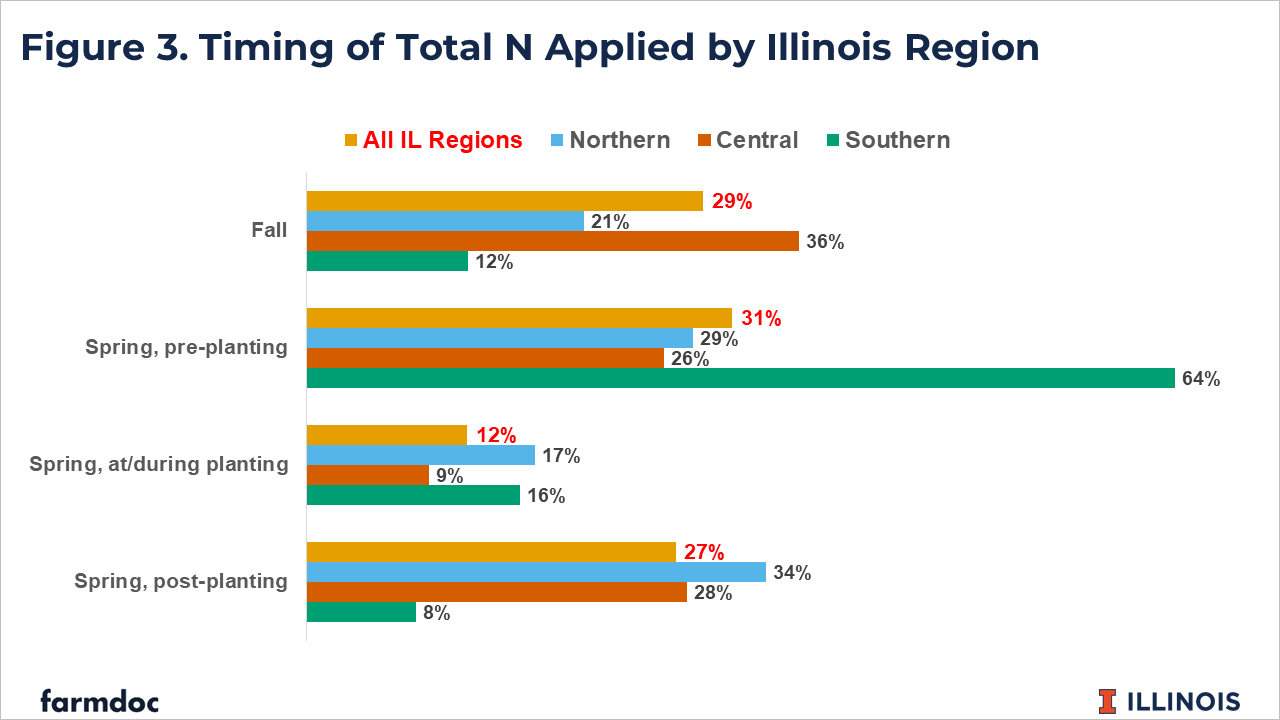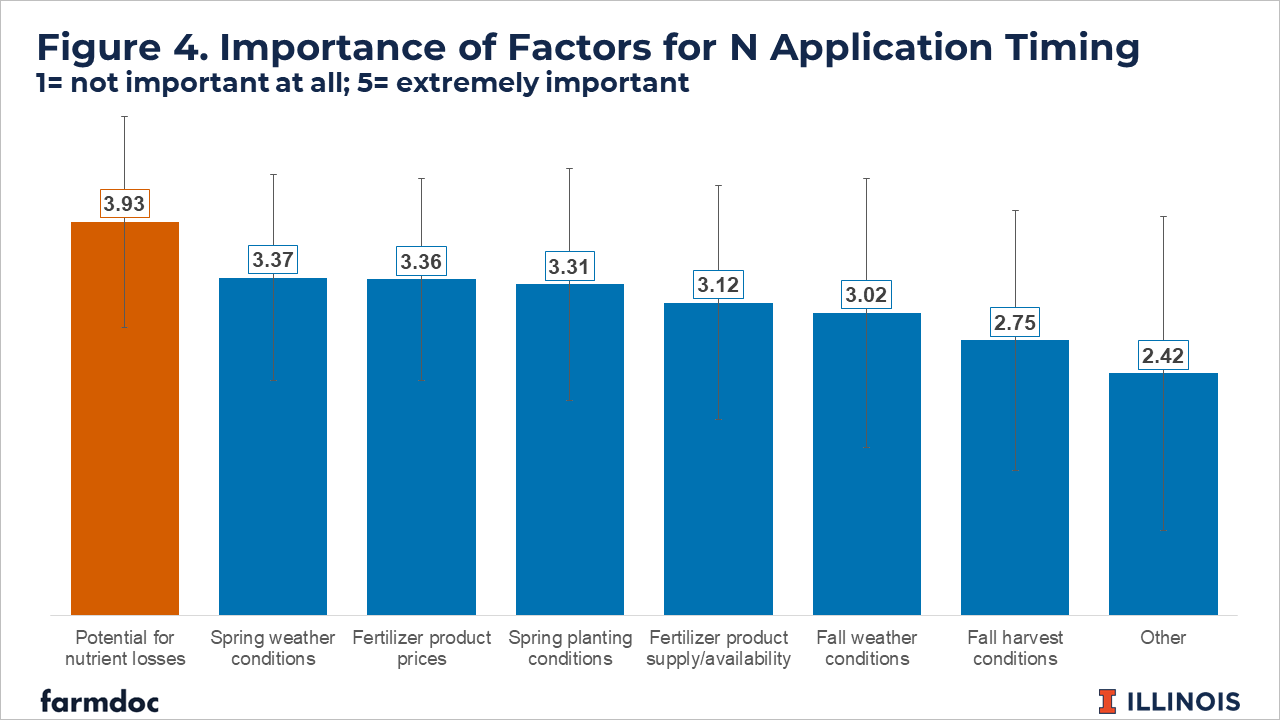Factors Influencing Nitrogen Fertilizer Application Rates and Timing in Illinois
Many factors influence fertilizer application decisions including crop rotation, weather, prices, expected returns and nutrient management considerations. Nitrogen is an essential nutrient for the production of many crops, including corn (see farmdoc daily May 29, 2025). Recent spikes in fertilizer prices (see farmdoc daily, August 15, 2023; September 12, 2023) and ongoing global supply concerns associated with the war between Russia and Ukraine (see farmdoc daily April 5, 2022) have led to increased fertilizer costs and increased availability concerns among producers. This leads to greater incentives for farmers to optimize fertilizer efficiencies to control costs and limit nutrient losses.
This article provides some results from a farmdoc survey of farmers conducted in the fall of 2024 focused on their input decisions and local input markets. Results suggest that farmers consider various factors and utilize a range of sources of information in making their application rate and application timing decisions. While multiple factors impact application timing decisions, nutrient losses are a top-ranked consideration among surveyed Illinois farmers.
Farmer Survey
In the fall of 2024 we conducted an online survey as part of a research project supported by the Illinois Corn Growers’ Association. The purpose of the study was to assess the state of local markets for fertilizers and other inputs for agricultural producers. In today’s article we include results from the survey questions focused on nitrogen application rate and timing decisions, and the sources of information used and factors impacting those decisions. A total of 198 survey responses were collected, of which 141 were from farmers that produce corn in the Midwest. Here we focus on the 110 responses received from Illinois farmers.
Figure 1 introduces the regional composition and farm size (acres) of respondents across Illinois. The majority of responses came from central Illinois farms with less than 2,500 acres. Most were from grain operations with no livestock enterprises, with approximately 50% owned land and 50% rented. About 40% of respondents indicated their nitrogen is mainly custom applied, 25% mainly self-apply their nitrogen, and the remainder include a mix of both. When custom applied, most farmers use local private retailers or cooperatives.
Application Rates
In Illinois, farmers’ use of liquid nitrogen solutions (44%), anhydrous ammonia (34%) and Urea (10%) accounts for nearly 90% of total nitrogen (N) applied to corn acres. Moreover, approximately 81% of Illinois respondents consider the N content in applied phosphorous products when determining their N application rates.
To determine rates, Illinois farmers rely on multiple sources of information, as illustrated in Figure 2. Most farmers rely on 3 to 4 information sources (see Figure 2, panel A) when determining nitrogen application rates. For farmers who consult only 1 or 2 sources, University Extension recommendations and independent professional advisors are the most popular. Retailer recommendations and soil test results also play an important role in guiding N rate decisions. Information sources include an increasingly broad mix for farmers who consult 3 or more sources in making their N rate decisions, with both fertilizer and corn prices playing more important roles (see Figure 2, panel B).
Application Timing
In terms of application timing, an average of 29% of corn acres in Illinois receive nitrogen fertilizer in the fall. This varies regionally across the state, with fall N applications playing a larger role in Central Illinois and a smaller role in Southern Illinois (see Figure 3).
The remaining nitrogen applications are applied in the spring, either pre-planting (31%), at or during planting (12%) or post-planting (27%). Nearly two-thirds of the N applied by farmer respondents in Southern Illinois is done before planting in the spring. Spring applications in Northern and central Illinois tend to be more balanced between pre- and post- planting applications, each accounting for 25-35% of total N applied.
Farmers surveyed were also asked to rate the importance of several factors when deciding the timing of application. Respondents answered on a scale from 1 to 5, where 1 meant “not important at all” and 5 meant “extremely important”. Average rankings for each factor are reported in Figure 4.
The potential for nutrient losses was rated the most important factor for N application timing decisions by the Illinois farmer respondents. Spring weather and planting conditions and fertilizer prices were the next highest ranked factors with similar averages. Fertilizer availability and fall weather and harvest conditions are also important factors but received lower average rankings by the respondents.
Further breakdowns by region and farm size showed greater even greater consideration of nutrient losses for larger farms in Central and Northern Illinois. For Southern Illinois farmers, spring weather conditions received the highest average ranking.
Discussion
The survey indicates that most farmers consider multiple sources (3 or more) when making their N application rate decisions. Recommendations from University Extension and independent crop advisors play important roles for farmers who consult fewer sources (1-2) with others – including retailer recommendations, soil testing results, and fertilizer and corn prices – becoming larger relative factors as the number of sources consulted increases. This indicates that Extension systems continue to be an important and trusted source of information. However, given the range of sources used by farmers, information and results need to be communicated broadly to stakeholders, including advisors and retailers serving farmers, to increase impact and benefits.
While N application timing varies regionally across the state, the majority of the nitrogen applied to corn acres by survey respondents occurs in the spring as opposed to the fall. When asked about the importance of factors to determine the timing of applications, Illinois farmers ranked the potential for nutrient losses as the most important. Considering and minimizing nutrient loss can improve crop yields (Nafziger, October 25, 2023; Fontes and Nafziger, May 9, 2024), reduce fertilizer costs (see farmdoc daily September 19, 2023 and January 14, 2025), and play an important role in policy design (see farmdoc daily April 18, 2024).
As discussed in a previous article (see farmdoc daily May 29, 2025), the efficiency of fertilizer use by U.S. crop farmers is increasing, particularly nitrogen use on corn acres. The survey results seem consistent with this trend. Farmers are using a wide range of sources to make N rate decisions, and their application timing decisions are driven by several factors including nutrient losses.
Summary
This article summarized some results from a recent farmer survey on the drivers of nitrogen application rate and timing decisions among Illinois farmers. Rising production costs and fertilizer price volatility have increased incentives for fertilizer efficiency, encouraging farmers to invest more time and consider more information sources for N rate and timing decisions.
The survey suggests Illinois farmers consult a range of information sources in making their N rate decisions. University Extension systems, crop advisors, soil test results, and retailer recommendations play important roles. Market conditions, including fertilizer and crop prices, also impact N application rates.
Application timing varies regionally across Illinois, but the majority of N applied to corn acres is done so at various points in the spring. The trend towards more spring-applied N is consistent with nutrient loss potential being the most important factor in timing decisions among the farmers surveyed.
Future articles in this series will focus on trends in the global supply chain for fertilizers and other inputs, providing additional analysis from our survey of farmers.
References
Coppess, J., S. Ruppert and M. Skidmore. "A Menace Reconsidered, Part 4: Losing Nitrogen." farmdoc daily (14):74, Department of Agricultural and Consumer Economics, University of Illinois at Urbana-Champaign, April 18, 2024.
Fontes, G., E. Nafziger. "Wet Spring Weather and Nitrogen Loss Revisited." Department of Crop Sciences, University of Illinois at Urbana-Champaign, May 9, 2024.
Monaco, H., N. Paulson and G. Schnitkey. "Trends in Fertilizer Use and Efficiency in the U.S." farmdoc daily (15):98, Department of Agricultural and Consumer Economics, University of Illinois at Urbana-Champaign, May 29, 2025.
Nafziger, E.. "Nitrogen Supply for the Corn Crop." Department of Crop Sciences, University of Illinois, October 25, 2023.
Paulson, N., G. Schnitkey, C. Zulauf, J. Colussi and J. Baltz. "Fertilizer Prices Continue Decline and May Impact Farmers’ Nitrogen Decisions." farmdoc daily (13):150, Department of Agricultural and Consumer Economics, University of Illinois at Urbana-Champaign, August 15, 2023.
Paulson, N., C. Zulauf, G. Schnitkey, J. Colussi and J. Baltz. "How Historic Were Fertilizer Prices in 2022?" farmdoc daily (13):165, Department of Agricultural and Consumer Economics, University of Illinois at Urbana-Champaign, September 12, 2023.
Paulson, N., C. Zulauf, G. Schnitkey, J. Colussi and J. Baltz. "Variability in Nitrogen Fertilizer Prices in Illinois Over the Last 15 Years." farmdoc daily (13):170, Department of Agricultural and Consumer Economics, University of Illinois at Urbana-Champaign, September 19, 2023.
Paulson, N., G. Schnitkey, B. Zwilling and C. Zulauf. "Revised 2025 Crop Budgets." farmdoc daily (15):9, Department of Agricultural and Consumer Economics, University of Illinois at Urbana-Champaign, January 14, 2025.
Schnitkey, G., N. Paulson, C. Zulauf, K. Swanson, J. Colussi and J. Baltz. "Nitrogen Fertilizer Prices and Supply in Light of the Ukraine-Russia Conflict." farmdoc daily (12):45, Department of Agricultural and Consumer Economics, University of Illinois at Urbana-Champaign, April 5, 2022.
Disclaimer: We request all readers, electronic media and others follow our citation guidelines when re-posting articles from farmdoc daily. Guidelines are available here. The farmdoc daily website falls under University of Illinois copyright and intellectual property rights. For a detailed statement, please see the University of Illinois Copyright Information and Policies here.











